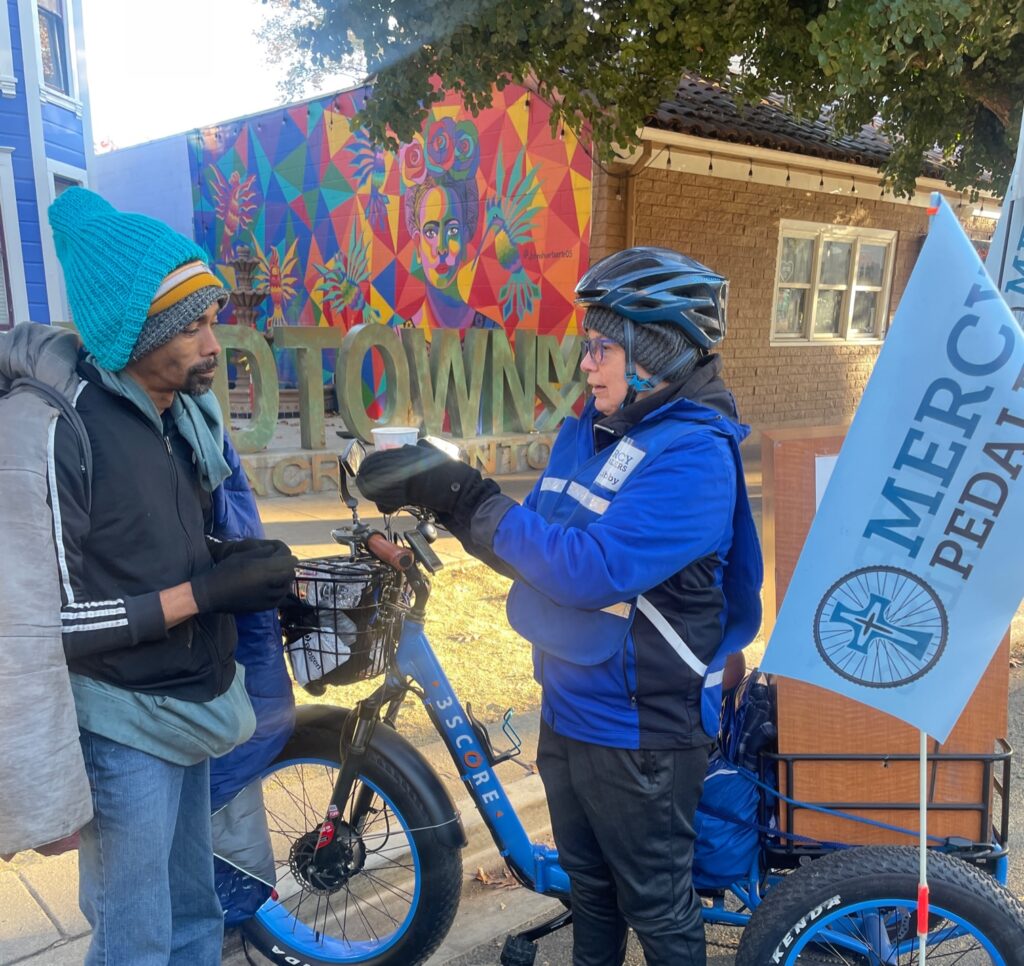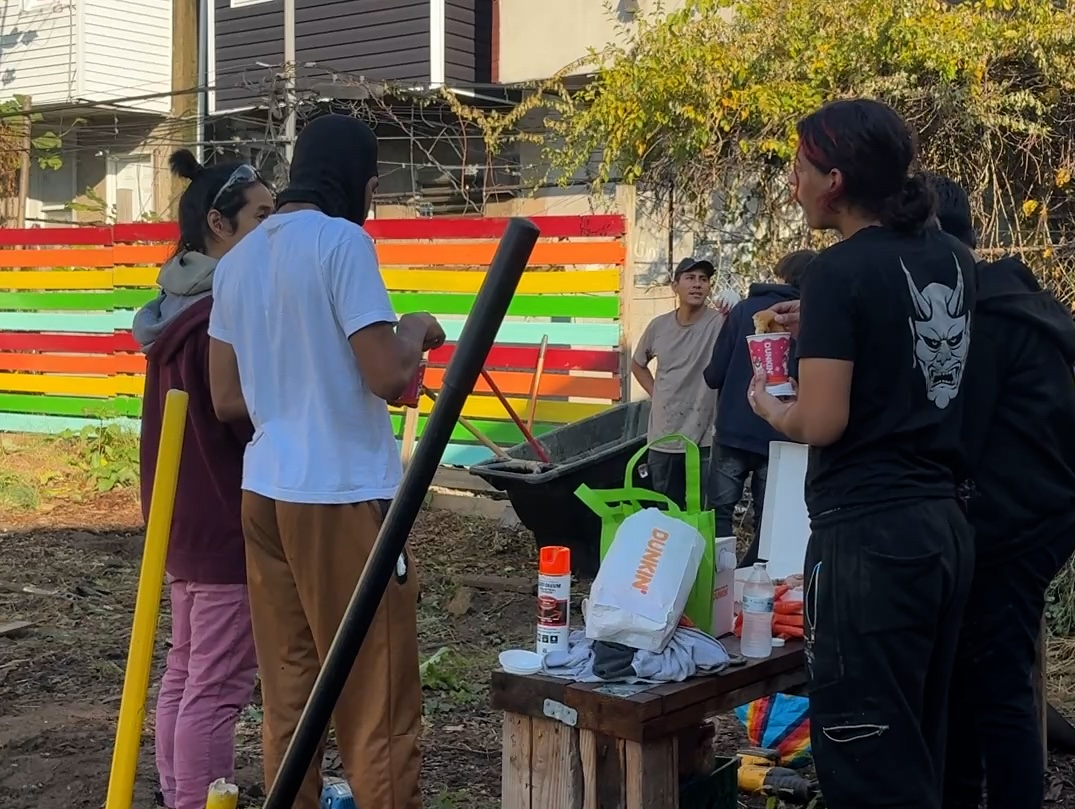(SACRAMENTO, Calif.) — With a ring of the bell on the handlebars of her motorized tricycle and a gracious smile, Sister Libby Fernandez is on her way again. Fernandez rides a two-mile loop every day to serve men and women experiencing homelessness on the streets of downtown Sacramento. Today, she is all stocked up with various toiletries and supplies, hats, gloves, granola bars, water, and a fully-stocked, on-the-go hot chocolate and coffee bar on the back of her trike.
It is the coldest morning in Sacramento this fall so far, 34 degrees with a freeze warning in effect. Fernandez, however, is unfazed.
“I’m going to get Maurice some hot chocolate,” said Fernandez as she greeted a grinning, middle-aged man sitting on the sidewalk surrounded by his miscellaneous belongings. “Cadillac? That’s half coffee, half hot chocolate. I’ve got a pair of gloves [for you] too.”
Fernandez founded the non-profit organization, Mercy Pedalers, in 2017, and has since gained the help of more than 300 volunteers to bike around the city and serve the homeless. Before Mercy Pedalers, Fernandez spent 20 years as the executive director at Loaves & Fishes, the largest homeless service provider in Sacramento.
“I love biking so I said, why don’t I try an outreach ministry and go to the people? Here, we can go anywhere we want and have that one-on-one and try to connect with them,” said Fernandez. In Sacramento, homeless encampments and tents line the sidewalks in front of government buildings while professionals dressed in suits and ties walk by, tapping away on their cell phones, seemingly oblivious to the human health and public safety crisis surrounding them.
As the numbers of unhoused individuals rise year-to-year in the city and state, politicians continue to argue about how to address homelessness. Last year, the number of people experiencing homelessness reached about 9,300, a 67% increase from 2019. The COVID-19 pandemic, unaffordable housing, and lack of shelters, recovery opportunities, and medication are all factors that contribute to this growing problem.
The Mayor of Sacramento, Darrell Steinberg, and Sacramento County District Attorney, Thien Ho, have been at odds over how to deal with the issue. Mayor Steinberg has led the City of Sacramento in his role as mayor since 2016, while District Attorney Ho was elected as the Sacramento County District Attorney in 2022. The City of Sacramento and the County of Sacramento are two separate entities within the city’s government.
Despite previous collaboration between the City and the County, Ho sued the City of Sacramento in September for a lack of action and accountability in tackling the issue of homeless encampments across the town. Over the past few months, the back-and-forth between the politicians has brought more attention to their feud and less action to combatting homelessness, leaving citizens, community organizers, and non-profit organizations like Mercy Pedalers to bear the responsibility of serving unhoused individuals across the city.
“Wait lists are keeping people out. When you’re ready, you’re ready, you just can’t wait,” said Fernandez of shelter availability in the city. Many of the homeless men and women she works with on a daily basis face roadblocks to proper care. She says they have to sign up for long lists just to get into emergency shelters, apply for affordable housing, and get into drug recovery programs.
California has the largest homeless population in the country, according to a report by the California State Auditor. While Californians only make up 12% of the nation’s population, they amount to 51% of the United States’ unsheltered population. Despite such astonishing numbers, some argue that not much has been done at the local and state levels to curb homelessness in the state. They fear that the lack of proactivity from government leaders will only cause the numbers of those experiencing homelessness, mental health issues, and drug addiction to grow.
100 miles south of Sacramento, the homeless crisis is just as visible in San Francisco. Comparable to major cities like Los Angeles and New York City, the number of unsheltered people in San Francisco is astounding. According to the U.S. Department of Housing and Urban Development Point-In-Time (PIT) Count, nearly 8,000 people experienced homelessness in the city in 2022.
Drug addiction and the fentanyl crisis impact the lives of many living on the streets of San Francisco. Community activist, JJ Smith, explains that the lack of funding in treatment centers and drug tourism contribute to the growing homelessness problem in San Francisco. Smith, a retired chef turned citizen journalist, walks the streets of his neighborhood every day as a form of exercise and records his interactions with the unhoused community.
“Each one of them told me that they came here to The Tenderloin because it’s easy access to the drugs that they choose to use,” said Smith. “If people are not walking around speaking to them constantly, treatment won’t even be on their minds. They know that when I come, [treatment] is what I’m talking about.”
Smith posts his interviews with the men and women experiencing homelessness and drug addiction in San Francisco’s Tenderloin district on his X (Twitter) account, where he has garnered the attention of media outlets and community leaders, and brought authentic visibility to the growing health and safety crisis. He shared that his mission is to not only shed a light on these individuals’ experiences, but to also offer help to those in need.
“For me, it’s not about if they accept [help] or not, it’s about building that friendship with them and letting them know that if they ever do want to change, and they can’t find anyone at that moment, they know that they can come to me,” said Smith. Back in Sacramento, Fernandez says there are three things that contribute to the growing homeless crisis in the city.
“Housing, recovery, medication. We definitely don’t have enough affordable housing for so many people,” said Fernandez. “There’s not enough recovery for drug and alcohol use… and people aren’t able to access their medications on a regular basis.”
District Attorney Ho’s lawsuit against the City of Sacramento came after many meetings and letters between both parties exchanging demands and ideas for change that, Ho claims, did not come to fruition. He called on the city to increase temporary emergency shelter offerings and enforce ordinances for unlawful camping and encampments, amongst many other demands.
When asked what the County is actively doing to combat homelessness, Janna Hayes, a public information officer for Sacramento County, shared the following in an email response:
“The City and County of Sacramento reached a landmark partnership deal in December 2022 that provides enhanced support and investment from the County. Investments include developing and operating up to 200 beds in a Safe Stay community… opening a behavioral health CORE center within the downtown area, as well as earmarking HEART clinicians to co-deploy with the Department of Community Response within the [city] to address behavioral health needs.”
The Department of Homeless Services and Housing, an entity of Sacramento County, works directly with men and women experiencing homelessness to provide programs, services, and resource information. The creation of a Local Homeless Action Plan, created in 2022, led the department to collaborate with the City of Sacramento and other organizations to establish and apply strategies to curb the city’s homelessness crisis. While the City of Sacramento and the County of Sacramento have worked together to bring relief to the homeless crisis in the past, conflict has still ensued between both parties in recent months.
In response to The Click’s request for comment on Ho’s lawsuit filing, the City of Sacramento, Office of the City Manager, who oversees the citywide response to homelessness, shared a link to statements from the Mayor and City Attorney. On this web page, Mayor Steinberg issued the following statement:
“No local government in the Sacramento region has done more to address the crisis on our streets: 1,200 new emergency beds, ordinances to protect sidewalks, schools and other sensitive sites; a legally binding partnership with the County; thousands of new affordable housing units—to name a few. The frustration that members of our community feel is absolutely justified. The Council has endorsed and is pressing for strong enforcement of our codes and the law. But the [District Attorney’s] lawsuit will not clear a single sidewalk nor get a single person off the streets.”
Sacramento City Attorney Susana Alcana Wood echoes Mayor Steinberg’s sentiments in a statement on the same webpage, saying that “collaboration [with the County] is the best path forward. However, it sadly appears [Ho] would rather point fingers and cast blame than partner to achieve meaningful solutions for our community.”
In a press conference on Sept. 19 officially announcing his lawsuit against the City, Sacramento District Attorney Ho said: “The unhoused are living in conditions typical of third-world countries, all the while the rest of the community is stuck between compassion and chaos.”
Ho said that by asking the City to clean up the encampments and enforce regulations requiring the unhoused individuals to relocate, “we are simply holding the City accountable by the same laws they enforce on us.” Fernandez manages to have faith despite the ongoing legislative debate surrounding the issue of homelessness in Sacramento. Along with the efforts of herself and more than 300 Mercy Pedaler volunteers, Fernandez said she brings city leaders and politicians on ride-alongs so the homeless don’t become invisible.
Two years ago, Fernandez met Sean and Vanessa, a couple who are both 34 years old, while serving the unhoused on the streets of Sacramento. She has fostered a close relationship with them throughout the years. Today, she spots them again on her route from midtown to downtown.
“Hi Sean, it’s so good to see you!” Fernandez pulls her trike over to the curb on L St., just a block away from the Capitol building, as she spots two familiar faces. She shares that Sean and Vanessa are expecting a baby in January and are on the waitlist for affordable housing in the area. “It takes time but when you can connect and know people at a different level, they really trust you and when things happen, they can come to you and get those resources,” said Fernandez. She chatted with the couple and shared snacks and toiletries before riding off. “Now remember, when you get your home, let me know so I can bring you a housewarming gift.”
While the lawsuit between the City and County of Sacramento is ongoing, the result of an amendment filed by Ho in December, community activists say they won’t wait to activate change. “I always stop when I see Sister Libby,” said John Epson, a 63-year-old man who lives on the streets of Sacramento. He said he has known Fernandez for 10 years.
Fernandez greets Epson with the same gracious smile she shares with everyone. She asks about his well-being as though they are lifelong, old friends, and gives him coffee and toiletries on this colder-than-usual fall morning. “My hands are freezing. I can barely move my fingers,” said Epson. “I’m gonna go right here to Methodist and have breakfast, take a hot shower.”
Fernandez replied, “I’m going to pray for you now.” Epson thanked Fernandez, as they both said their goodbyes and planned to go about their days. Before leaving, Epson looked back at Fernandez. “Good to see you, Sister Libby. See you tomorrow.”


